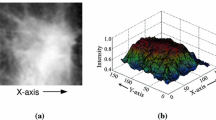Abstract
In the screening mammographic examination of large parts of populations thousands of mammograms are analysed. The Computer Aided Diagnosis methods available still tend to produce too many false positive (FP) detections with respect to the number of true positive (TP) detections, which makes it impractical to use such methods to support the human observer in the analysis of mammograms. In this paper an attempt has been made to decrease the number of FP errors in the hierarchical correlation-based cancerous mass detection method by eliminating the images of linear structures (LSs) from the mammograms. The LSs were detected with an accumulationbased line detector and the image intensity function in the regions of the LSs was interpolated with an anisotropic membrane. Examples of images representing typical detection problems caused by the LSs selected from the MIAS database suggest the feasibility of the proposed approach.
Access this chapter
Tax calculation will be finalised at checkout
Purchases are for personal use only
Preview
Unable to display preview. Download preview PDF.
Similar content being viewed by others
References
Bator M, Nieniewski M (2006) The usage of template matching and multiresolution for detecting cancerous masses in mammograms. In E. Picetka et al (eds), Proc. 11th Int. Conf. Medical Informatics & Technology, Wisla-Malinka, Poland, 25–27 Sept 2006, pp 324–329
Blake A, Zisserman A (1987) Visual Reconstruction. MIT Press, Cambridge, MA, London
Chmielewski L (2006) Detection of non-parametric lines by evidence accumulation: Finding blood vessels in mammograms. In K. Wojciechowski et al (eds) Computer Vision and Graphics: Proc. Int. Conf. Computer Vision and Graphics ICCVG 2004, volume 32 of Computational Imaging and Vision, Warsaw, Poland, 22–24 Sept, 2004. Springer, Berlin Heidelberg New York, pp 373–380
Chmielewski L (2005) Specification of the evidence accumulation-based line detection algorithm. In Kurzyński M., Woźniak M, Puchala E et al. (eds). Proceedings of international conference on computer recognition systems CORES 2005, Rydzyna, Poland, 22–25 May 2005. Volume of Advances in Soft Computing. Springer, Berlin Heidelberg New York, pp 355–362
Chmielewski LJ (2006) Metody akumulacji danych w analizie obrazów cyfrowych. Akademicka Oficyna Wydawnicza EXIT, Warszawa
Dziukowa E, Wesolowska E (eds) (2006) Mammografia w diagnostyce raka sutka. Medipage, Warszawa, second edition
Hong B-W, Brady M (2003) Segmentation of mammograms in topographic approach. In Proc. IEE Int. Conf. on Visual Information Engineering VIE’03, Guildford, U.K., July 2003
Kopans DB (1998) Breast Imaging. Lippincott-Raven, Philadelphia
Liu S, Babbs CF Delp EJ (2001) Multiresolution detection of spiculated lesions in digital mammograms. IEEE Trans Image Proc 10(6):874–884
Rangayyan RM, Ayres FJ (2006) Gabor filters and phase portraits for the detection of architectural distortion in mammograms. Med Bio Eng Comput 44(10):883–894
Sampat MP, Markey MK, Bovik AC (2005) Computer-aided detection and diagnosis in mammography. In Bovik AC (ed) Handbook of Image and Video Processing. Academic Press, pp 1195–1217
Sheshadri HS, Kandaswamy A (2005) Detection of breast cancer tumor based on morphological watershed algorithm. ICGST Int J Graph Vision and Image Proc 05(V5):17–21
Suckling J, Parker J et al (1994) The Mammographic Images Analysis Society digital mammogram database. In: Gale AG, Astley SM et al (eds) Digital Mammography. Exerpta medica international congress series, vol 1069, pp 375–378
te Brake GM, Karssemeijer N (1999) Single and multiscale detection of masses in digital mammograms. IEEE Trans Med Imaging 18(7):628–639
Thangavel K, Karnan M et al (2005) Automatic detection of microcalcifications in mammograms — A review. ICGST Int J Graph, Vision and Image Proc 05(V5):31–61
Zwiggelaar R, Astley SM et al (2004) Linear structures in mammographie images: detection and classification. IEEE Trans Med Imaging 23(9):1077–1086
Zwiggelaar R, Parr TC et al (1999) Model-based detection of spiculated lesions in mammograms. Med Image Anal 3(l):39–62
Author information
Authors and Affiliations
Editor information
Editors and Affiliations
Rights and permissions
Copyright information
© 2007 Springer-Verlag Berlin Heidelberg
About this paper
Cite this paper
Bator, M., Chmielewski, L.J. (2007). Elimination of Linear Structures as an Attempt to Improve the Specificity of Cancerous Mass Detection in Mammograms. In: Kurzynski, M., Puchala, E., Wozniak, M., Zolnierek, A. (eds) Computer Recognition Systems 2. Advances in Soft Computing, vol 45. Springer, Berlin, Heidelberg. https://doi.org/10.1007/978-3-540-75175-5_75
Download citation
DOI: https://doi.org/10.1007/978-3-540-75175-5_75
Publisher Name: Springer, Berlin, Heidelberg
Print ISBN: 978-3-540-75174-8
Online ISBN: 978-3-540-75175-5
eBook Packages: EngineeringEngineering (R0)




